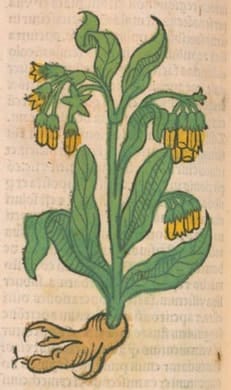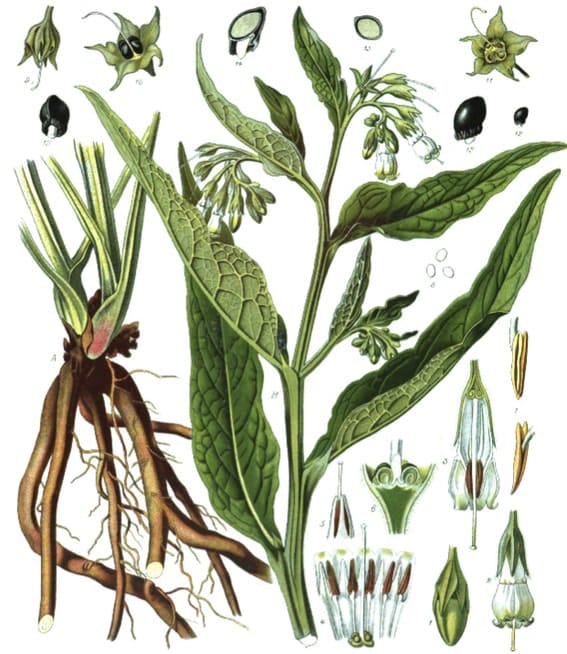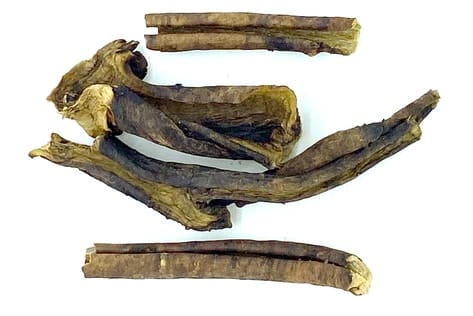Symphytum, ComfreyConsolida Major |

|

|
 Ortus Sanitatis, Meydenbach, 1491
Ortus Sanitatis, Meydenbach, 1491 Koehler’s Medizinal Pflanzen, 1887
Koehler’s Medizinal Pflanzen, 1887 Comfrey root (Adam, 2022)
Comfrey root (Adam, 2022) Members CLICK HERE for the PRO VERSION
Members CLICK HERE for the PRO VERSIONBotanical name:
Symphytum officinale
Other related species such as the Russian Comfrey (Symphytum x uplandicum) and Prickly Comfrey (S. asperum) have been used, but these should be avoided due to the higher levels of toxic alkaloids.
Parts used:
Root; Leaf
Temperature & Taste:
Cool, neutral in respect of moisture (some said Temperate). Sweet, Bitter
Classifications:
2C INCIDERS. 2D ATTENUATERS OF CONGEALED BLOOD. 2L. EMOLLIENT. 2O. ASTRINGENT. 2P. HEMOSTATIC. 2T. GLUTINATE
2W. SARCOTIC. 2X. INCARNATIVE
3L. ANTI-TUSSIVE. 3M. ARTHRITIC
4f. SPLENETIC. 4k. ARTHRITIC
TCM:
B. Clears Heat, Cools the Blood B. Clears Deficient Heat
Uses:
1. Nourishes the Yin, Strengthens the Kidneys and Bones:
-lower back and knee weakness; chronic back pain and acute back strain
-Fractures. injuries, degeneration to the bones and joints, for which it was considered by many to be a specific.
-Tendonitis, Arthritis, Gout and Rheumatism etc.
2. Clears Heat, Stops Bleeding and Leakages:
-bleeding from heat, such as Hematuria, spitting of Blood, Excessive or profuse Menstruation, and Irregular Uterine Bleeding.
-Ulcerative Colitis, Diarrhea, Dysentery, and Leukorrhea, with or without blood;
3. Clears Heat, Nourishes Yin, Promotes Healing:
-tidal or hectic fevers with dry throat, and a rapid but faint pulse.
-internally and externally for all Ulcers including those of the Stomach, Bowels, Lungs, Vagina etc.
4. Nourishes the Blood:
-strengthens the Blood, and helps increase circulation. By nourishing Yin and Blood, it is useful in a variety of chronic diseases.
5. Clears Heat and Phlegm, Stops Coughs:
-irritable coughs, Bronchitis, Laryngitis, Whooping Cough, Pneumonia
-Tuberculosis, Emphysema, Lung Ulcers
6. Clears Heat, Moves the Blood, Resolves Masses:
-‘separates clotted Blood’. (Lonicerus, Krauterbuch, 1564)
–Scrofulous diseases from Phlegm and Heat; Lymphadenitis, swollen Lymph nodes
7. Externally:
-all Trauma, Wounds, Bruises, Fractures
-Ulcers: ‘In ulcerative conditions and burns its utility is confirmed by numerous observers’ (Lancet, 1912); its external use for Ulcers was accepted as the main indication by the German Commission E; used for Varicose Veins, Varicose Ulcers, slow and chronic suppurating Ulcers (especially of the Leg), and Gangrenous Ulcers
-‘Running Sores’ and ‘Rodent Ulcers’ (Basal Cell Carcinoma).
-Burns and Scalds
-acute and chronic inflammations including Mastitis from milk obstruction.
-injured or inflamed Periosteum.
-topically for Gout .
-The tincture relieves neuralgic pains, especially facial neuralgia.
-An old European remedy for Scars, and is said to regenerate aging skin.
-Traditionally used for vaginal tears associated with Birth.
-Gum pain, inflammation and wounds such as after dental surgery.
Dose:
… available in PRO version
Substitute:
… available in PRO version

Main Combinations:
Comfrey & Plantain
Licorice & Comfrey
Bleeding
1. Bleeding:
i. Comfrey root with … available in PRO version
ii. Hemoptysis and other types of Bleeding from Heat, Comfrey with … available in PRO version
iii. Comfrey root with … available in PRO version
iv. Comfrey root with … available in PRO version
v. Comfrey root … available in PRO version
vi. Comfrey … available in PRO version
vii. Comfrey with … available in PRO version
viii. Excess Menstrual bleeding, Comfrey with … available in PRO version
Trauma, Wounds
2. Wounds, Trauma, Bruising, and Internal Bleeding:
i. Comfrey with … available in PRO version
ii. Comfrey root, … available in PRO version
iii. Comfrey, … available in PRO version
iv. oil for external use, Comfrey, … available in PRO version
3. Vulnerary formulas for Wounds and Trauma:
i. Comfrey with … available in PRO version
ii. Comfrey with … available in PRO version
4. Plaster for Fractures:
i. … available in PRO version
ii. Comfrey root, … available in PRO version
5. Internally for Fractures, put Comfrey and … available in PRO version
Ulcers
6. Bladder or Kidney Ulcers, Comfrey root, … available in PRO version
7. Stomach Ulcers:
i. Comfrey root … available in PRO version
ii. Comfrey root with … available in PRO version
8. Lung Ulcer, Comfrey root … available in PRO version(Gazophylacium Medico-Physicum, Woyts, 1746)
9. Liver Ulcers, Comfrey with … available in PRO version
Hernias
10. Hernias:
i. Comfrey root with … available in PRO version
ii. Comfrey root with … available in PRO version
iii. Comfrey root with … available in PRO version
iv. Comfrey root with … available in PRO version
v. Comfrey with … available in PRO version
vi. Comfrey, … available in PRO version
vii. Take Conserve of Comfrey with … available in PRO version
11. Plaster for Hernia:
i. Comfrey root, … available in PRO version
ii. Comfrey, … available in PRO version
Lungs
12. To strengthen the Lungs:
i. Comfrey root with … available in PRO version
ii. Comfrey, … available in PRO version
13. Whooping Cough:
i. Comfrey, … available in PRO version
ii. Comfrey leaf, … available in PRO version
14. Consumption:
i. Comfrey, … available in PRO version
ii. Comfrey, … available in PRO version
iii. Comfrey, … available in PRO version
Astringent
15. Diarrhea, Dysentery:
i. Comfrey root … available in PRO version
ii. Comfrey with … available in PRO version
iii. Comfrey with … available in PRO version
16. Mucous Colitis, Comfrey leaf, … available in PRO version
17. Leukorrhea:
i. Comfrey root with … available in PRO version
ii. Comfrey root with … available in PRO version
18. Excessive Menstruation:
i. Comfrey, … available in PRO version
Other
19. Cancer, Comfrey … available in PRO version
20. Varicocele, Comfrey with … available in PRO version
21. Gonorrhea, Comfrey root … available in PRO version
22. Emollient Gargle, decoct Comfrey root with … available in PRO version
23. Postpartum pain:
i. Comfrey with … available in PRO version
ii. Comfrey with … available in PRO version
24. Dryness of the mouth, … available in PRO version
25. Weakness or looseness of the joints:
i. boil Comfrey with … available in PRO version
ii. Weak or Lax Joints, Comfrey, … available in PRO version
26. Back Pain, Comfrey, … available in PRO version
Major Formulas:
Infusion for Hernia (Wirtzung)
Decoction of Comfrey and Solomans Seal
Decoction of Timaei (modified)
Decoction to Strengthen the Lungs
Decoction for Excessive Menstruation
Universal Vulnerary Decoction (Joseph Du Chesne)
Syrup of Plantain and Comfrey (Boyles Syrup)
Syrup of Comfrey Compound
Wine for Incontinence
Electuary of Comfrey (Fioravantus)
Powder for Bleeding of Galen
Powder for Bruises (Lemery)
Powder for After-pains (Midwife to the Queen of France)
Powder for After-pains (Lemery)
Powder for Hernia (Pharmacopoeia Extemporanea)
Powder to Break Blood Above and Below (Nicholas)
Pills Against Fluxes (Nicolas)
Cautions:
1. Not used during Pregnancy or while breastfeeding
2. Toxic in overdose or long-term use. Should not be used in those with Liver disease.
Comfrey, like other Pyrrolizidine-alkaloid (PA) containing plants has become controversial and its internal use is banned in a number of countries. In parts of Europe, Comfrey has been traditionally eaten as a food where there are reportedly no greater incidences of Liver disease. However, research has demonstrated potential Hepatotoxic effects. In general, Comfrey is traditionally used for short periods of time, especially as a wound herb. In these cases, use for 2–3 weeks should pose no risk. However, it is best avoided in the very young, elderly, while pregnant and breastfeeding, and in those with Liver disease. Its topical use is regarded as safe.
According to Hoffman, “Between 85% and 97% of the PAs in Symphytum officinale (True/Common) commonly grown in American gardens are built around the less toxic retronecine monoester. However, Russian comfrey (Symphytum peregrinum), contains higher levels of the diester, which, is known to have a greater toxicity.” (See here). Further, echimidine is the most toxic PA in comfrey species and is found in higher amounts in Russian and Prickly Comfrey, not S. officinalis.
It is also important to note that toxic alkaloids are found in higher amounts in the root, therefore making the leaf a safer option for internal use.
An exhaustive review of literature found 8 suspected cases of adverse events from oral intake of Comfrey. However, as the authors noted, other factors such as medication taken simultaneously or incorrect identification could not be ruled out. The authors stated “Based on these case reports, the evidence of harm caused by these plants is weak.” (see here)
Toxicity:
–Oral toxicity study of certain plant extracts containing pyrrolizidine alkaloids
–The comparative toxicity of a reduced, crude comfrey (Symphytum officinale) alkaloid extract and the pure, comfrey-derived pyrrolizidine alkaloids, lycopsamine and intermedine in chicks (Gallus gallus domesticus).
–Metabolism, genotoxicity, and carcinogenicity of comfrey.
–Hepatotoxicity of Pyrrolizidine Alkaloid Compound Intermedine: Comparison with Other Pyrrolizidine Alkaloids and Its Toxicological Mechanism
–Safety of medicinal comfrey cream preparations (Symphytum officinale s.l.): The pyrrolizidine alkaloid lycopsamine is poorly absorbed through human skin.
Main Preparations used:
Distilled Water, Conserves of the Flower, Conserve of the Root, Candied Root, Syrup of the Root, Extract of Comfrey (including the ‘Bloody Extract’), Powder, Decoction and Mucilage
-
Extra Info
- Research
